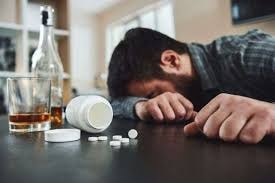Alcohol Addiction Medication: Options, Effectiveness, and How They Work
If you’re looking for ways to treat alcohol addiction, medications like Naltrexone, Acamprosate, and Disulfiram can be effective. This article explores these alcohol addiction medication options, their effectiveness, side effects, and when they should be considered as part of a treatment plan.
Key Takeaways
- Naltrexone is the most effective medication for alcohol addiction, reducing heavy drinking by 83%, while Acamprosate supports abstinence and Disulfiram deters alcohol consumption through adverse reactions.
- Medications for alcohol use disorder work best when combined with behavioral therapies, addressing both the physical and psychological aspects of addiction to improve long-term outcomes.
- Monitoring and patient evaluation are crucial when prescribing alcohol addiction medications, particularly for those at risk of withdrawal or with underlying health conditions.
What is the most effective medication for alcohol addiction?
Clinical research highlights that Naltrexone reduces heavy drinking by 83% compared to placebo, making it one of the most effective medications for alcohol use disorder, according to the National Institute on Alcohol Abuse and Alcoholism (NIAAA). The top FDA-approved medications for alcohol addiction include Naltrexone, Acamprosate, and Disulfiram, each with varying degrees of success.
Naltrexone, Acamprosate, and Disulfiram have different effects on alcohol use:
- Naltrexone is particularly effective in reducing alcohol consumption and cravings.
- Acamprosate excels in maintaining abstinence.
- Disulfiram, though less consistent, works by deterring alcohol consumption through adverse reactions if alcohol is ingested.
Each of these medications plays a unique role in helping individuals control their alcohol intake and achieve long-term sobriety. Understanding their effectiveness and how they work is crucial for anyone considering medication as part of their treatment for alcohol use disorder.

Alcohol addiction medications compared: Naltrexone vs. Acamprosate vs. Disulfiram
Naltrexone blocks cravings; Disulfiram causes aversion. These contrasting mechanisms highlight the varied approaches of the three main medications prescribed for managing alcohol dependence. Naltrexone, Acamprosate, and Disulfiram each have distinct:
- Use cases
- Dosages
- Mechanisms
- Efficacy rates
- Side effects
Naltrexone is effective in decreasing heavy drinking days and promoting abstinence, while Acamprosate focuses on maintaining abstinence.
Understanding these differences can help individuals and healthcare providers choose the most appropriate three medications based on specific needs and circumstances. The following sections provide an in-depth look at each medication, detailing their mechanisms, effectiveness, and potential side effects.

Naltrexone (ReVia, Vivitrol)
Naltrexone works by blocking the pleasurable effects associated with alcohol consumption, significantly reducing cravings. Available in both oral naltrexone (ReVia) and long acting injectable naltrexone forms, the injectable version is often more effective for some patients. Naltrexone is an opioid antagonist, meaning it blocks opioid receptors in the brain, which helps reduce alcohol consumption and cravings.
The typical starting dose of Naltrexone is 25 mg, which can be increased to 50 mg after a week, and it is often recommended to be taken after meals to minimize side effects. Common side effects include gastrointestinal issues like nausea and vomiting, generally mild and tend to decrease over time.
Naltrexone is contraindicated for individuals dependent on opioids, and those exploring treatment options may benefit from understanding the comparison between naltrexone vs suboxone.
Acamprosate (Campral)
Acamprosate helps stabilize the chemical balance in the brain disrupted by alcohol, aiding recovery after detox. Known as Campral, this FDA-approved medication modulates neurotransmitters by balancing glutamate and GABA, potentially alleviating withdrawal symptoms and reducing cravings for alcohol. Acamprosate demonstrates a good safety profile and does not significantly interact with other drugs, making it suitable for patients with liver issues.
Clinical trials show that Acamprosate is effective in decreasing the likelihood of returning to drinking after treatment compared to placebo. However, it does not significantly reduce the number of fewer heavy drinking days when compared to placebo.
Common side effects include gastrointestinal issues like diarrhea and unpleasant symptoms, but these are generally mild.
Disulfiram (Antabuse)
Disulfiram deters alcohol consumption by causing unpleasant reactions when alcohol is ingested, promoting abstinence. It works by inhibiting an enzyme that metabolizes acetaldehyde, leading to toxic buildup if alcohol is consumed. This medication is most effective for individuals committed to sobriety and who have already stopped drinking.
Disulfiram is taken orally once daily, with doses typically ranging from 125 mg to 500 mg.
Key points about Disulfiram:
- Taken once daily orally
- Typical dose range: 125 mg to 500 mg
- Effects can linger in the system for up to two weeks after the last dose
- Prolonged presence increases potential for adverse reactions if alcohol is consumed
Disulfiram works best when integrated into a broader treatment plan that includes behavioral treatment therapies.
How do medications help treat alcohol use disorder (AUD)?
Medications like Acamprosate and Naltrexone are FDA-approved for treating alcohol use disorder and can help lower alcohol consumption and boost abstinence rates:
- Acamprosate supports abstinence by restoring GABA balance.
- Naltrexone reduces cravings by blocking opioid receptors in the brain.
- Disulfiram works by causing unpleasant reactions when alcohol is consumed, which can discourage drinking.
These medications are most effective when integrated with behavioral counseling interventions and support systems. This comprehensive approach addresses both the physical and psychological aspects of addiction, leading to better long-term outcomes. Using medication alongside therapy aids in managing stress, controlling cravings, and preventing withdrawal symptoms.

When should someone consider alcohol addiction medication?
Individuals should consider alcohol addiction medication if:
- They find it difficult to control their drinking despite negative impacts on their personal and social life.
- They experience alcohol cravings or withdrawal symptoms when not drinking.
- They have attempted to quit drinking alcohol multiple times without success.
- Their alcohol consumption leads to serious health issues or safety concerns.
Knowing how to help someone with alcohol addiction includes encouraging them to consult a healthcare professional for evaluation and a tailored treatment plan. This plan may include medication as part of a broader strategy involving group therapy and support groups to support recovery, ensuring health and care excellence.

How are alcohol addiction medications prescribed and monitored?
Clinicians are advised to:
- Screen adults for alcohol misuse and provide brief counseling to those with risky drinking behaviors.
- Prescribe medications for alcohol use disorder only after assessing the patient’s risk for alcohol withdrawal and conducting an initial psychiatric evaluation.
- Treat patients diagnosed with alcohol use disorder using a combination of medications and behavioral therapy.
Monitoring liver function is crucial for patients prescribed Naltrexone due to the risk of hepatotoxicity and liver dysfunction. Compliance with medication regimens like Disulfiram is often increased when taken under supervision.
Follow-up appointments and regular monitoring of drinking behavior help assess the effectiveness of the treatment and make necessary adjustments.
Who should not take alcohol addiction medication?
Individuals over the age of 65 are at an increased risk for harmful interactions with alcohol addiction medications due to physiological changes and potential for polypharmacy. Patients taking sedative medications or opioids should avoid these medications due to the heightened risk of severe respiratory depression and overdose when combined with drinking alcohol.
People with a history of severe liver disease should be cautious, as many alcohol addiction medications can exacerbate liver damage and liver-related problems. Additionally, pregnant women are generally advised against using these medications due to potential risks to fetal development.
Side effects and risks of alcohol addiction medications
Common side effects of alcohol addiction medications can include nausea, headaches, and dizziness. Some medications may cause allergic reactions, resulting in symptoms like rash or difficulty breathing. Certain medications can lead to severe withdrawal symptoms if alcohol is consumed while taking them.
Long-term use of these medications can result in dependence or increased tolerance. Patients experiencing severe reactions should consult their healthcare provider immediately to adjust the treatment plan and avoid further complications related to severe renal dysfunction.
Do medications work without therapy or rehab?
Medications alone can reduce cravings but are three times more effective when combined with behavioral therapy. Solely relying on medications without any form of therapy often leads to higher chances of relapse. While medications can reduce cravings and withdrawal symptoms, they do not address the underlying behavioral issues related to addiction.
Successful treatment of alcohol use disorder usually requires a comprehensive approach that includes both medications and counseling, including alcohol treatment and addressing substance abuse and alcohol problems. This combined treatment model helps individuals develop coping strategies, manage stress, and maintain long-term sobriety.
Over-the-counter alternatives and their risks
Some over-the-counter medications can help alleviate mild alcohol withdrawal symptoms but shouldn’t substitute professional medical treatment. Natural supplements like kudzu and B-vitamins may support liver health and address deficiencies in individuals with alcohol use disorder. However, self-treatment with OTC drugs poses risks and may lead to severe complications if not monitored by healthcare professionals.
Before using any OTC medications during alcohol withdrawal, consulting a healthcare provider is crucial to avoid withdrawal symptoms and adverse interactions. OTC medications are not effective for managing severe withdrawal symptoms like seizures and delirium tremens, which require immediate medical supervision.
Future of alcohol addiction medication: What’s next in treatment?
New drug classes, such as glucagon-like peptide-1 receptor agonists (GLP-1RAs) and phosphodiesterase-4 inhibitors, are showing potential for treating alcohol use disorder. GLP-1RAs, originally designed for diabetes and obesity, are being studied for their potential in treating alcohol addiction by affecting brain reward systems. Preliminary research indicates that GLP-1RAs might help reduce cravings and substance use by modulating dopamine signaling in the brain.
Ongoing studies aim to better understand the long-term safety and efficacy of GLP-1RAs in treating alcohol use disorder. Regulatory approval for GLP-1RAs as treatments for addiction is still pending, as current approvals focus mainly on metabolic disorders.

Bottom Line: Alcohol addiction medication
Understanding the different medications available for treating alcohol addiction is crucial for anyone seeking to overcome alcohol use disorder. Naltrexone, Acamprosate, and Disulfiram each play unique roles in reducing cravings, maintaining abstinence, and deterring alcohol consumption. These medications are most effective when combined with behavioral therapy and support systems.
As we look to the future, emerging treatments and personalized medicine offer hope for more effective and individualized approaches to treating alcohol addiction. By staying informed and working with healthcare providers, individuals can find the best treatment plan to achieve long-term sobriety and improve their quality of life.
FAQs about alcohol addiction medication
Can I drink while on these medications?
Mixing alcohol with certain medications can have serious health consequences, including increased risk of overdose and harmful side effects. Disulfiram can lead to intense adverse effects if you drink alcohol while on this medication, making it crucial to avoid drinking while on this medication.
How long do I need to take medication for alcohol addiction?
The duration for which medication is prescribed often aligns with the alcohol recovery timeline, generally ranging from a few months to a year depending on individual progress. Patients may require medication for alcohol dependence for several months to over a year based on individual needs.
Is medication covered by insurance or Medicare?
Many insurance plans, including Medicare, provide coverage for medications used in the treatment of alcohol use disorder, though specifics can vary. Medicare Part D covers outpatient prescription drugs for alcohol use disorders, and individuals eligible for both Medicare and Medicaid might receive additional coverage.
















